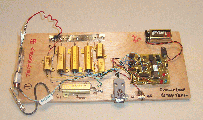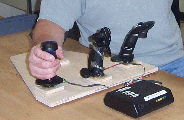|
©Copyright
1997-2010
Johnson
Kinetics, Inc.
All
Rights Reserved
Pages
best printed
in
Landscape
|
|
Product
Development
The level of Product Development can be identified
by:
1) Required Maturity
2) Performance Goals and Capability
3) Intended Audience
Once these questions are answered, you have a
better sense as to what level of service you require. Several stage
are described below. Please review our Engineering Services Section
to learn how JKI may help you realize your goals.
Feasibility Analysis.
Typically, an engineering, production, and marketing
review of the product, capability or goal. Although our aptitude
is the engineering and production, we work with other companies to identify
marketing potentials, cost and profitability analysis, perform focus groups
and other critical stages of product development.
JKI will identify and conduct some basic tests
to insure core product possibilities. Critical components, a review
of cost implications, features, consumer or technical interest,
Proof-of-Concept.
Further. A proof-of-concept device is not
necessarily a prototype, but can be. Half of POC builds are
breadboard / brassboard fabrications with some semi-finished parts, but
usually spread out over a bench top to evaluate and study each functional
module. Many POC items can be computer simulated, compensated for,
or designed in at the onset. In most applications, it is expected
that some features may be left out or require refinement, physical elements
or packaging may not be present.
There are several possibilities to what a Proof-of-concept
device constitutes, all based on the expectation and intended audience.
An simple of two interpretations of a POC effort are below.
 Case
1) In this example the goal was to build a test platform for analyzing
battery performance at high loads. A time-dependant variable load
was controlled by a microcontroller routine to analyze what batteries power
efficiency in 120 seconds. Tests were selected by inputs to
the microcontroller, voltage, power, and temperature data was collected
and sent to a PC for storage, graphing and analysis. Here the platform
could be considered a 'brassbound' or simply a 'test device' as its audience
was test engineers and aesthetics were secondary. Case
1) In this example the goal was to build a test platform for analyzing
battery performance at high loads. A time-dependant variable load
was controlled by a microcontroller routine to analyze what batteries power
efficiency in 120 seconds. Tests were selected by inputs to
the microcontroller, voltage, power, and temperature data was collected
and sent to a PC for storage, graphing and analysis. Here the platform
could be considered a 'brassbound' or simply a 'test device' as its audience
was test engineers and aesthetics were secondary.
 Case
2) In this example a fast turn-around requirement (3 days) was built
to introduce a concept, suggest possible solutions, and generate discussions
with engineering, intended users, and management. The goal then included
a portable aesthetic, adaptable device with indicators, simple controls,
and battery operation. This proof-of-concept device featured
hardware, a quick (but not dirty) test setup, embedded software, and circuitry. Case
2) In this example a fast turn-around requirement (3 days) was built
to introduce a concept, suggest possible solutions, and generate discussions
with engineering, intended users, and management. The goal then included
a portable aesthetic, adaptable device with indicators, simple controls,
and battery operation. This proof-of-concept device featured
hardware, a quick (but not dirty) test setup, embedded software, and circuitry.
Prototype.
Building a 'prototype' can mean constructing
any level of embodiment from Proof-of-Concept to Production models.
Usually it means a pre-production unit where all desired features are implemented,
the enclosure is close to a final. Obvious last steps including molding,
miniaturized components, interfaces are the discretion of the project manager.
The desired level of completion should be a primary specification.
Generational labels are not as important as defined goals for the outcome.
Test Unit Prototypes.
In some cases, units may be built for testing
and data collection. Such units may have built in telemetry or data
logging capabilities to allow developers to monitor and track how the product
is being used, to what level of performance, and in what environment.
Test units put in the field for a short term can tell developers a great
deal about the 'real world' to which their product is to be immersed.
Test Units are often numbered Client feedback is also of paramount importance.
A great deal of consideration, planning, ergonomics, etc. will be put in
on the front end. It is important to review those goals during actual
use.
Pre-Production.
In most cases, Pre-Production units are identical
(or nearly so) to what you intend to mass produce including enclosures,
features, communications, user interfaces, performance and power concerns.
JKI does not provide mass production services, but can transition you from
prototype to establishing final and polished building blocks of a device.
Costing.
The universal concern for a new project.
It is important to identify companies whose products or past contract engineering
services are close to the market, application, or performance characteristics
of your intended device.
The goal of your program, the phase of development,
maturity, interface packaging and other items may dictate what kind of
product to build. Our Engineering Services details our areas of expertise.
Contact us today.
//
|
|





